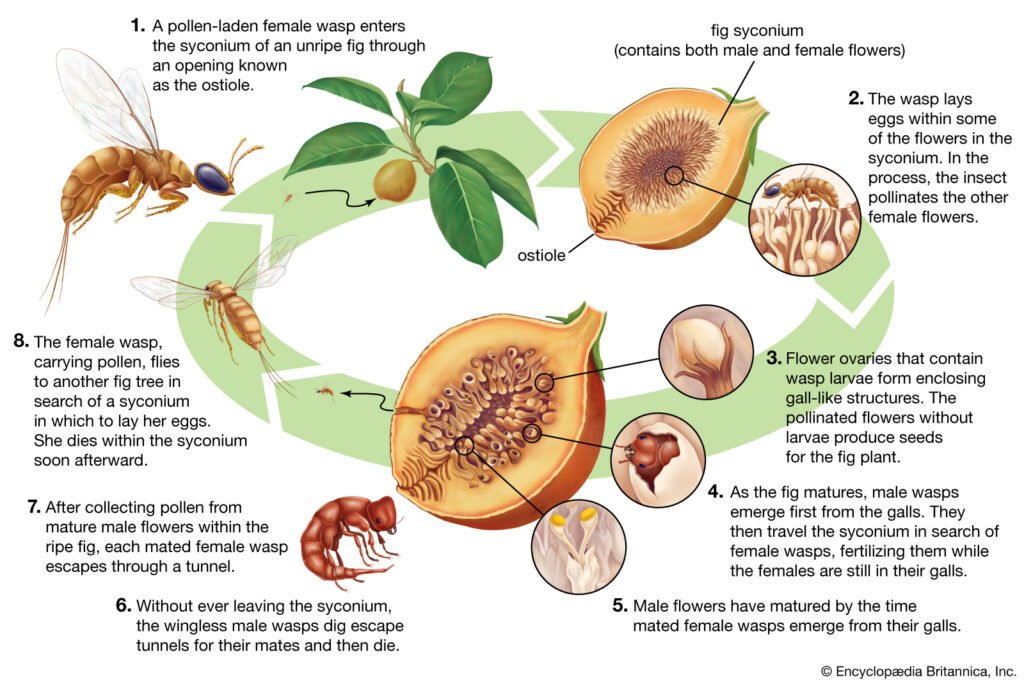The Banyan tree. What can one say about the Banyan tree?
That this is one of the most magnificent specimens of life on Earth?
That the branches of the trees encompass the very breadth of knowledge? You can study its significance historically, mythologically, politically, ecologically, economically… pretty much every -cally there is out there!
Much like its canopy, the study of the Banyan tree is limitless. But because of its magnificence, it is a study worth the time and effort. So let’s give it a go.
The Science of Banyan Trees
The Strangler
The scientific name of the Banyan tree is Ficus benghalensis and it is one species of the family of 750+ fig trees. These widest trees of the world are essentially hemi-epiphytic in nature. In biology, epiphytic means trees which grow out of seeds germinating in the nooks and crevices of other trees. The Banyan tree also starts off as a seed which is laid in the crevices of a host tree by a bird which expels it there after eating the banyan fruit. The seed germinates on the host tree and slowly grows around it for support. And then, instead of being grateful to its host, it strangles the host tree and blooms to glory in its place! [1]
The banyan tree is thus also called ‘strangler fig’.
The branches of the main trunk of the banyan tree soon grow and form a large canopy. In order to support such a large canopy, the banyan needs to do something. This brings us to its unique root system!
Roots And The Offshoots

Almost all of us in India have come across a Banyan tree at least once in our lives. What does it look like? It consists of a thick trunk, strong branches and beautiful dark green leaves. But the most unique aspect of the Banyan is its roots.
The Banyan has two types of roots- the tap root under the main trunk of the tree, and the prop roots growing out of the long branches and reaching out to the ground. Since these prop roots grow to provide the huge canopy of the Banyan tree structural support, they are also known as pillar roots. Upon reaching the ground, the roots form adventitious roots and thicken to such a degree that often the main trunk is indistinguishable from the prop roots. [2]
The Fig and The Wasp
Another amazing aspect of the banyan tree is its million year old coevolution with the fig wasp. The banyan tree has figs (not the Mediterranean fruit) growing on them. These figs are biologically part of a syconium. This syconium consists of a fleshy inner wall and a hollow interior. This interior consists of male and female flowers. The male flowers produce pollen and the female flowers have the requisite apparatus to get pollinated and produce their own individual fruits.
The syconium has a special opening called the ostiole. When the syconium is ready for pollination, the ostiole loosens to let fig-wasps enter inside the syconium. These fig wasps will enter the syconium, pollinate the female flowers of the fig while laying their eggs inside. The wasps then die inside the fig.

The eggs inside the fig hatch and the male wasps become active after 4-6 weeks, mate with the female wasps and cut through the fig to create openings. The female wasps then squeeze out of the fig, collecting pollen from the male flowers while doing so, and then escape the fig to pollinate other trees. [3]
And hence, the banyan and the wasps help each other reproduce and thrive.
Interestingly, the shape of the ostiolar opening of the fig is extremely specific in shape for specific species of fig-wasps. Hence, specific species of fig trees are codependent on specific species of fig-wasps for survival. And vice-versa.
A metres-long tree and a centimetres-long insect. Who would have thought?
The Length And Breadth Of It
The tree is native to the Indian subcontinent and grows pretty much everywhere in India. It can also be found in quite a few countries of the subcontinent.[4]

Once Upon A Time In India...
In Ancient India
And now, let’s move to the history and mythology of this magnificent tree. Known as the bargad tree in India, it seems like the bargad has always been a part of the Indian psyche. The banyan tree was a recurring motif found on Indus Civilization’s seals and pottery. There is a tablet which portrays a banyan tree with a god living inside it and two stars flanking its base, signifying a cosmic relation. [5] It is believed that nature-centric Indus Valley Civilization believed that trees were the abode of gods. Perhaps the Banyan tree was one of them, related to a form of proto-Shiva. [6]
The Rig Veda, dated around 1000 BCE, contains a hymn about the roots of a cosmic banyan tree being held up in the sky by God Varuna. It is believed that a cosmic banyan tree existed whose roots faced the sky and the branches and leaves touched down on Earth, essentially carrying the blessings of the Gods to the Earth.
The Tree of Permanence
The Banyan has both a mythological and spiritual connect for India. It has a long lifecycle and the branches seem to extend onwards infinitely. Hence, in India, and particularly in Hinduism, the tree signifies immortality and permanence.
In Hinduism, sage Markandeya had a vision that the entire world ended with a flood or deluge. In the midst of this deluge, he saw an infant Vishnu floating on a Banyan Tree leaf. The infant seemed to absorb the entire destroyed world around him and then expelled a refreshed new reborn world. The vision was a symbol of the fact that every thing in this world is temporary. But God’s grace is permanent and with that grace will humanity be always reborn. This form of Krishna or Vishnu is called vata-patra-shayin. And this leaf is the leaf of the Banyan tree, the tree of permanence. [7]

The Tree of Death
But permanence sometimes also means stifling growth. Unlike other trees, the Banyan tree does not let other forms of plants thrive under it. It provides evergreen shelter to humans, but have barely edible fruit. It is hence related to Lord Yama- the God of Death. The banyan tree is often planted near crematoriums and is considered to house ghosts within it.
However, on the opposite spectrum of death, on a Hindu festival called Vat-Purnima, women pray to the banyan tree and tie sacred threads around it for the long lives of their husbands. This is because of a story that a woman called Savitri earned the blessings of Lord Yama and brought back her husband from death.
The Tree of Spirituality
Due to its seemingly permanent and immortal form, and perpetual evergreen shade, the Banyan tree is seen as the the epitome of stability. It is seen as the equivalent of the Soul in Hinduism- while the Body lives and dies, the Soul is constant, stable and permanent.
It is believed that hermits and sages lived not for the Body, but for the Soul. And a number of mythological and religious sages and hermits have sat underneath the Banyan and reflected upon the reality of life.
The first hermit is Shiva, the God who unafraid of death due to his vast knowledge, faces South in the direction of mortality and change. This form of Shiva is known as Dakshinamurti and is found in the south-facing walls of South Indian temples.
It is also said that Krishna recited teachings of the Bhagavad Gita as he stood under the banyan tree at Jyotisar, Haryana. Apart from Hinduism, the Banyan tree is also considered sacred in Buddhism as Gautam Buddha sat under it for seven days to meditate. Jains consider this tree sacred because their first tirthankar Rishabhnath received enlightenment under it.
Overall, whatever the era or religion, the Banyan tree has changed the way the world thinks spiritually.
The European Discovery
Among Europeans, it was Alexander the Great’s army which probably first came across the banyan tree in India in 326 BCE. This was the famous Kabir banyan tree of Kabirvad Island, Gujarat. But till then, Indians knew this tree as vat-vriksha. It was the more recent Portuguese invaders who gave the banyan tree its modern name.
The Portuguese would often see Gujarati traders of the baniya community sitting under the banyan tree to discuss their business and set their stalls. This is how the bargad tree got its name. The word banyan is a derivative of the word, ‘baniya’.
Unfortunately, while the Portuguese named the Banyan, the British shamed it. During their 400-year-old rule over India, multiple freedom fighters and other Indians were hung to their death from banyan tree branches. In some instances, multiple bodies would be hanging under the canopy of a single large banyan tree.
In Modern India
After India gained its independence, it restored the dignity of this very symbolic and important tree by declaring it as the National Tree of India. It is also the state tree of Gujarat and Madhya Pradesh.
A number of modern Indian iconic entities are influenced by the Banyan tree— be it the heart of Indian decentralised governance, the gram panchayat, which usually meets under the hospitable shade of the evergreen banyan tree. Or the famous city of Vadodara, which owes its name to the Banyan tree which grows abundantly there. Vadodara is derived from the Sanskrit word vatodar, meaning ‘in the belly of the Banyan tree’. The banyan tree is also the birthplace of India’s first formal stock exchange, the Bombay Stock Exchange. The BSE also started in the shade of the banyan tree where stockbrokers would meet in the 1850s. It was also a Banyan which inspired Rabindranath Tagore in Shantiniketan and under which he mentored the next generation of Indian leaders and thinkers.

Today, the Bargad tree is still important not only for its religious significance, but also its cultural and historical roots in its local neighborhoods. Many parts of the tree are used for medical purposes, while the prop roots are used for creating structural elements.
But the most important aspect of the Banyan Tree is the ecological one. Even though this tree is related to death in India, it provides shelter to a number of birds and animals and help in the pollination of hundreds of other species. It is truly the ecological lynchpin of its local ecosystem.
Coming up next: A list of amazing and historically important Banyan Trees in India.
References
- Trees with a Difference: The Strangler Figs, Nature Watch, Vidya R Athreya
- A Report on Different Types of Aerial Roots, Ramakrishna T.M., Poornima S. and Vimala R, World Journal of Pharmacy and Pharmaceutical Sciences, Volume 4, Issue 06, 794-797, ISSN 2278- 4357
- Wasp Composition in Inflorescences of Two Dioecious Fig Species- Implications for the Fig-Wasp Mutualism, Aviva Patel, Biotropica, Vol. 30, No. 3, 474-480
- Invasive Species Compendium, Centre For Agriculture and Bioscience International
- ‘Hind Leg’ + ‘Fish’: Towards Further Understanding
of the Indus Script, Asko Parpola, University of Helsinki, SCRIPTA, Volume 1 (September 2009): 37-76 - Tree Gods of Indus Civilization, Jeyakumar Ramasami
- Baby of the Banyan Leaf, www.devdutt.com



